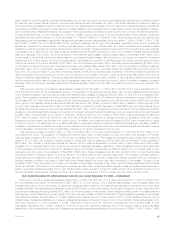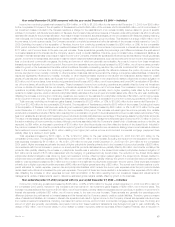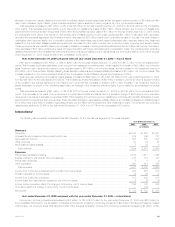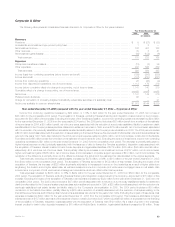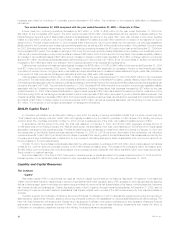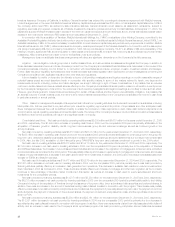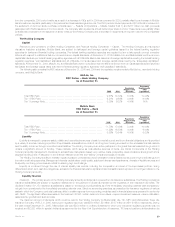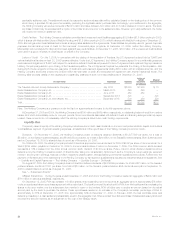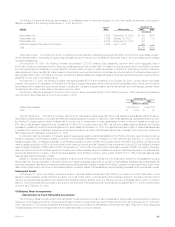MetLife 2005 Annual Report Download - page 27
Download and view the complete annual report
Please find page 27 of the 2005 MetLife annual report below. You can navigate through the pages in the report by either clicking on the pages listed below, or by using the keyword search tool below to find specific information within the annual report.increases were offset by a reduction in corporate support expenses of $16 million. The remainder of the increase is attributable to intersegment
eliminations.
Year ended December 31, 2004 compared with the year ended December 31, 2003 — Corporate & Other
Income (loss) from continuing operations decreased by $27 million, or 300%, to ($36) million for the year ended December 31, 2004 from
($9) million for the comparable 2003 period. The 2004 period includes a $105 million benefit associated with the resolution of issues relating to the
Internal Revenue Service’s audit of Metropolitan Life’s and its subsidiaries’ tax returns for the years 1997-1999. Also included in 2004 is an expense
related to a $32 million contribution, net of income taxes, to the MetLife Foundation and a $9 million benefit from a revision of the estimate of income
taxes for 2003. The year ended December 31, 2003 includes a $92 million benefit, net of income taxes, from the reduction of a previously established
liability related to the Company’s race-conscious underwriting settlement, as well as a $36 million benefit from a revision of the estimate of income taxes
for 2002. Excluding the impact of these items, income from continuing operations increased by $19 million in the year ended December 31, 2004 from
the comparable 2003 period. The increase in earnings in 2004 over the prior year period is primarily attributable to an increase in net investment income
of $184 million and a decrease in policyholder benefits and claims of $24 million, both of which are net of income taxes. This increase is partially offset by
an increase in net investment losses of $93 million and an increase in interest on bank holder deposits of $14 million, a charge related to unoccupied
space of $10 million, as well as expenses associated with the piloting of a new product of $7 million, all net of income taxes. In addition, the tax benefit
increased by $41 million as a result of a change in the Company’s allocation of tax expense among segments.
Total revenues, excluding net investment gains (losses), increased by $269 million, or 157%, to $440 million for the year ended December 31, 2004
from $171 million for the comparable 2003 period. The increase in revenue is primarily attributable to increases in income on fixed maturity securities,
corporate joint venture income, mortgage loans on real estate and equity securities due to increased invested assets and higher yields. Also included as
a component of total revenues are intersegment eliminations which are offset within total expenses.
Total expenses increased by $199 million, or 50%, to $594 million for the year ended December 31, 2004 from $395 million for the comparable
2003 period. The year ended December 31, 2004 includes a $50 million contribution to the MetLife Foundation, partially offset by a $22 million reduction
of interest expense associated with the resolution of all issues relating to the Internal Revenue Service’s audit of Metropolitan Life’s and its subsidiaries’ tax
returns for the years 1997-1999. The year ended December 31, 2003 includes a $144 million benefit from a reduction of a previously established liability
associated with the Company’s race-conscious underwriting settlement. Excluding these items, total expenses increased by $27 million for the year
ended December 31, 2004. This increase is attributable to higher interest expense of $61 million as a result of the issuance of senior notes at the end of
2003 and during 2004, as well as higher interest credited to bank holder deposits of $22 million as a result of growth in MetLife Bank’s business. This
increase is partially offset by a decrease of $54 million from lower interest expense on surplus notes, as well as lower expenses from policyholder benefits
and claims of $38 million, a charge related to unoccupied space of $15 million, as well as expenses associated with the piloting of a new product of
$11 million. The remainder of the increase is attributable to intersegment eliminations.
MetLife Capital Trust I
In connection with MetLife, Inc.’s initial public offering in April 2000, the Holding Company and MetLife Capital Trust I, a wholly-owned trust, (the
‘‘Trust’’) issued equity security units (the ‘‘units’’). Each unit originally consisted of (i) a contract to purchase, for $50, shares of the Holding Company’s
common stock (the ‘‘purchase contracts’’) on May 15, 2003; and (ii) a capital security of the Trust, with a stated liquidation amount of $50.
In accordance with the terms of the units, the Trust was dissolved on February 5, 2003, and $1,006 million aggregate principal amount of
8.00% debentures of the Holding Company (the ‘‘MetLife debentures’’), the sole assets of the Trust, were distributed to the owners of the Trust’s capital
securities in exchange for their capital securities. The MetLife debentures were remarketed on behalf of the debenture owners on February 12, 2003 and
the interest rate on the MetLife debentures was reset as of February 15, 2003 to 3.911% per annum. As a result of the remarketing, the debenture
owners received $21 million ($0.03 per diluted common share) in excess of the carrying value of the capital securities. This excess was recorded by the
Company as a charge to additional paid-in capital and, for the purpose of calculating earnings per share, is subtracted from net income to arrive at net
income available to common shareholders.
On May 15, 2003, the purchase contracts associated with the units were settled. In exchange for $1,006 million, the Company issued 2.97 shares
of MetLife, Inc. common stock per purchase contract, or 59.8 million shares of treasury stock. The excess of the Company’s cost of the treasury stock
($1,662 million) over the contract price of the stock issued to the purchase contract holders ($1,006 million) was $656 million, which was recorded as a
direct reduction to retained earnings.
Due to the dissolution of the Trust in 2003, there was no interest expense on capital securities for the years ended December 31, 2005 and 2004.
Interest expense on the capital securities is included in other expenses and was $10 million for the year ended December 31, 2003.
Liquidity and Capital Resources
The Company
Capital
Risk based capital (‘‘RBC’’) requirements are used as minimum capital requirements by the National Association of Insurance Commissioners
(‘‘NAIC’’) and the state insurance departments to identify companies that merit further regulatory action. RBC is based on a formula calculated by applying
factors to various asset, premium and statutory reserve items and takes into account the risk characteristics of the insurer, including asset risk, insurance
risk, interest rate risk and business risk. These rules apply to each of the Company’s domestic insurance subsidiaries. At December 31, 2005, each of
the Holding Company’s domestic insurance subsidiaries’ total adjusted capital was in excess of the RBC levels required by their respective states of
domicile.
The NAIC adopted the Codification of Statutory Accounting Principles (‘‘Codification’’) in 2001 to standardize regulatory accounting and reporting to
state insurance departments. However, statutory accounting principles continue to be established by individual state laws and permitted practices. The
New York State Department of Insurance (the ‘‘Department’’) has adopted Codification with certain modifications for the preparation of statutory financial
statements of insurance companies domiciled in New York. Modifications by the various state insurance departments may impact the effect of
Codification on the statutory capital and surplus of the Holding Company’s insurance subsidiaries.
MetLife, Inc.
24



